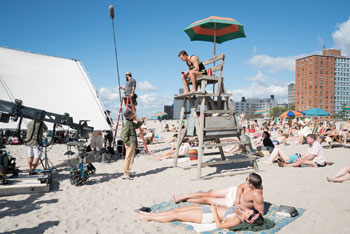Justin Timberlake Wonder Wheel
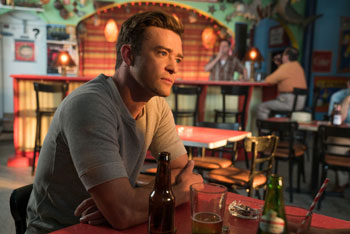
Period Drama set in New York in the 1950s.
Cast: Kate Winslet, Juno Temple, Justin Timberlake
Director: Woody Allen
Genre: Drama
Running Time: 101 minutes
Synopsis: Wonder Wheel tells the story of four characters whose lives intertwine amid the hustle and bustle of the Coney Island amusement park in the 1950s: Ginny (Kate Winslet), a melancholy, emotionally volatile former actress now working as a waitress in a clam house; Humpty (Jim Belushi), Ginny's rough-hewn carousel operator husband; Mickey (Justin Timberlake), a handsome young lifeguard who dreams of becoming a playwright; and Carolina (Juno Temple), Humpty's long-estranged daughter, who is now hiding out from gangsters at her father's apartment.
Reeling after the emotional breakdown brought on by her divorce, Ginny finds solace by marrying fellow lost soul Humpty, who is grieving from the death of his wife, and the departure of Carolina, who ran away to marry a local hoodlum. While Humpty has problems with alcohol and holding onto a job, he provides Ginny and her troubled son Richie (Jack Gore) with a home, albeit one in a cramped apartment in the midst of the cacophony of Coney Island amusement park's famed Wonder Wheel. Although Ginny finds a degree of stability with Humpty, she despairs at giving up her dreams for a waitressing job, her marriage to a man more interested in fishing than the finer things, and her inability to help Richie, who has his own emotional problems.
After her marriage to her gangster husband ends, Carolina is questioned by the FBI and knowing too much, it is imperative her ex-husband gets rid of her. Frightened and on the run, Carolina seeks out her father. Feeling she will not be traced there as the two have not spoken in years, he takes her in.
When Mickey sees Ginny walking forlornly alone on the beach one night, he approaches her, and they soon begin an affair. For Mickey, a relationship with an unhappily married woman flatters his romantic self-image, but he's not necessarily thinking long-term; Ginny, on the other hand, soon looks to Mickey as a lifeline with the potential to permanently rescue her from all the mistakes and disappointments of her past life.
Humpty is similarly rejuvenated by the re-emergence of Carolina in his life. Having a daughter around to love provides surprising joy, as well as a newfound purpose: setting aside money for her to attend night school.
However, Ginny and Humpty's precarious new hopes and dreams are soon threatened when Mickey lays eyes on Carolina for the first time.
Poetically photographed by Vittorio Storaro, Wonder Wheel is a powerful dramatic tale of passion, violence, and betrayal that plays out against the picturesque tableau of 1950s Coney Island.
Wonder Wheel
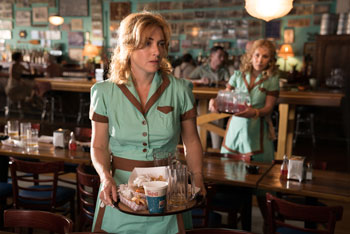 About The Production
About The Production
Woody Allen has always had a special fondness for Coney Island, and memorably set the childhood home of Annie Hall's Alvy Singer under the clattering Cyclone roller coaster. Woody Allen has many happy memories of going there often as a child. 'Its heyday was long before I was born, but when I went it was still pretty exciting," he says. 'It always impressed me. There were so many colourful people there, and so many conflicting and complex activities going on, and it was such a vital atmosphere. I thought it would be a very provocative atmosphere to set a dramatic story in."
Like so many of Woody Allen's films, Wonder Wheel is a story that involves love and betrayal.
'Whether you're reading Greek drama, Stendhal, Tolstoy, or Dickens, the love relationships are ever-present, because they cause so many people so much anguish, so much conflict. They lead to so many complex, deep, intense, confusing and dramatic feelings and situations. In particular, I have always been attracted to problems that women have. Over the centuries, the guys tend to be less readily demonstrative about their suffering. The male code is to not show suffering. Like when a batter gets hit by a pitcher, the idea is not to show any pain. Whereas women have always been more open about their emotions. I've done mostly comedies, but whenever I've turned to a dramatic story, it almost always – not always, but almost – has been about women in critical situations."
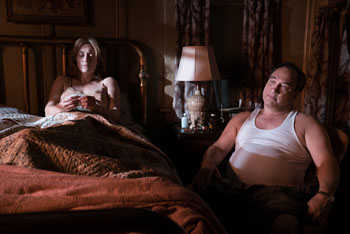 Woody Allen consciously writes his larger-than-life female roles, like Ginny in Wonder Wheel, with the idea of providing challenges that only the most gifted actresses can rise to. 'I try and cast actresses who have enormous range and enormous depth and intensity and I want to try and provide them with opportunities to exercise their great gifts," he says. 'When I'm writing a story, I have a tendency not to write very subtle scenes where emotion is conveyed with the raising of an eyebrow, but to give them much more flamboyant drama that gives an actress a chance to really be emotional."
Woody Allen consciously writes his larger-than-life female roles, like Ginny in Wonder Wheel, with the idea of providing challenges that only the most gifted actresses can rise to. 'I try and cast actresses who have enormous range and enormous depth and intensity and I want to try and provide them with opportunities to exercise their great gifts," he says. 'When I'm writing a story, I have a tendency not to write very subtle scenes where emotion is conveyed with the raising of an eyebrow, but to give them much more flamboyant drama that gives an actress a chance to really be emotional."
Without question, Ginny in Wonder Wheel is the latest in a long line of complex, richly observed and troubled Woody Allen heroines. 'I knew I needed a tremendous actress to play her," says Woody Allen. 'There are only a limited number of actresses in the English language that are that deep and that great. Kate Winslet is one of them, and when we started casting, her name came up quickly." While Kate Winslet recognised immediately that the role was an extraordinary opportunity, she worried she might not be up to it. 'I was terrified because I didn't know where I would begin," she says, 'and if I failed I would never forgive myself. It was the responsibility of playing someone who was that complex, not wanting her to fall into a cliché in any capacity, always wanting to stay the right side of the line, keep her real, not have her become a caricature in any way at all, and absolutely to keep her grounded in her awful reality. Woody Allen wanted to hire me and I had to step up to the plate and be the goods that he'd hired, and be the best possible version of those goods that I could find within myself."
When we first meet Ginny, she is working in a Coney Island clam house, trapped in a loveless marriage, and carrying the remnants of a painful past. 'Ginny had a tough early life," says Woody Allen. 'She scuffled her way up, had illusions about being an actress, and ended up marrying a gentlemen she really loved who loved her, and they had a child. But Ginny couldn't resist the temptation to have an affair with an actor who was in a show with her, and it caused a complete breakup of her marriage. She realised only when it was too late, the consequences of her infidelity and her actions. Then, she started falling apart, was drinking, and her work suffered." Says Kate Winslet: 'I think that Ginny believed that she was a good actress and could have had a career were it not for the fact that she ruined her marriage, but I think deep down the reality was that she was never any good. That moment of discovering that actually she was a dreadful actress luckily never came around. In some ways that makes it more tragic."
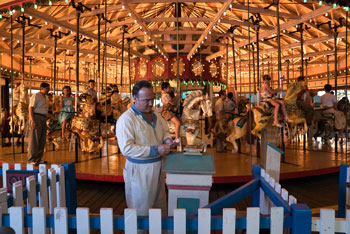 At this low point in her life, Ginny met Humpty (Jim Belushi), who was suffering himself, because his wife had died and his daughter Carolina had run off and married a local hoodlum. Even though Ginny and Humpty are able to help each other get back on their feet, eventually Ginny realises that, by marrying Humpty, she has settled into a life that will never satisfy her. 'Now that she's over the crisis, she starts to understand that she doesn't really love this man," says Woody Allen. 'He was a rock when she needed it and she helped him get off alcohol, but that's not what love is – love is what she had with her first husband. And she yearns for something more exciting than the practical aid that she and Humpty have supplied each other. She feels she's going under and her life is ebbing away." Says Kate Winslet: 'I think she's a bit of a lost soul. It's as though she spent a large part of her life walking on a tightrope, and she's just fallen one too many times. Now she's slithering along the tightrope, neither standing nor really falling anymore."
At this low point in her life, Ginny met Humpty (Jim Belushi), who was suffering himself, because his wife had died and his daughter Carolina had run off and married a local hoodlum. Even though Ginny and Humpty are able to help each other get back on their feet, eventually Ginny realises that, by marrying Humpty, she has settled into a life that will never satisfy her. 'Now that she's over the crisis, she starts to understand that she doesn't really love this man," says Woody Allen. 'He was a rock when she needed it and she helped him get off alcohol, but that's not what love is – love is what she had with her first husband. And she yearns for something more exciting than the practical aid that she and Humpty have supplied each other. She feels she's going under and her life is ebbing away." Says Kate Winslet: 'I think she's a bit of a lost soul. It's as though she spent a large part of her life walking on a tightrope, and she's just fallen one too many times. Now she's slithering along the tightrope, neither standing nor really falling anymore."
Jim Belushi portrays Ginny's aptly named husband Humpty, as like Ginny, he has had difficulty pulling himself together after a fall. 'Humpty is very weak to women, and he can't be alone," says Jim Belushi. 'He lost both of the women in his life at the same time. He was devastated, and it sent him into a drunken spiral. When Ginny turned up, she reached in and pulled him out of that abyss. And now even though he yells and carries on, it's Ginny who has the control, because he knows he can't lose her. If he loses Ginny, he'll die." Kate Winslet believes that Ginny also cannot live without Humpty. 'She can't be on her own because she is too vulnerable," says Kate Winslet. 'But what I love about Ginny is that her moments of fragility are extremely raw and very alive. She doesn't just become this weak, limp little character in a chair. She's fragile but she'll always bump through all the bumps in the road – whether she has to skip over them, leap over them, or roll over them, she'll always keep going."
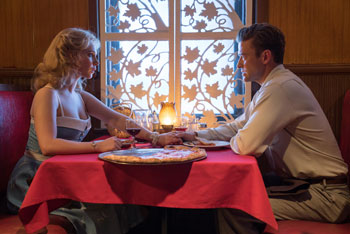 Ginny is not able to help Richie (Jack Gore), her son from her first marriage, who has begun to act out by setting fires all around Coney Island. 'It's very sad because on some level Ginny does feel like she's ruined Richie's life, and she does feel like it's all her fault that he's a moody miserable kid who sets fires. I feel she wants to do more for him, but doesn't quite know how. She's so consumed with the guilt that she's screwed up his life by cheating on his father, that it seems to disable her from being able to parent him."
Ginny is not able to help Richie (Jack Gore), her son from her first marriage, who has begun to act out by setting fires all around Coney Island. 'It's very sad because on some level Ginny does feel like she's ruined Richie's life, and she does feel like it's all her fault that he's a moody miserable kid who sets fires. I feel she wants to do more for him, but doesn't quite know how. She's so consumed with the guilt that she's screwed up his life by cheating on his father, that it seems to disable her from being able to parent him."
The couple's routine is broken by the unexpected arrival of Humpty's daughter Carolina (Juno Temple), who Humpty hasn't seen or spoken to in five years. 'Carolina was a girl who was, by the local standards, very beautiful," says Woody Allen. 'At some point, a local hoodlum made a play for her and took her to places where the local boys couldn't take her, and bought her furs and jewels. She was seduced by the glamour and they end up getting married. For a while they have a nice time together, but eventually things started to get more contentious in the marriage, and they broke up. Soon after, the FBI got to her and threatened her, so she told them some things about her ex-husband's business. At this point, she becomes a target for her ex-husband and his hit men, as she knows too much and they want to get rid of her." Says Juno Temple: 'I think Carolina was a young, hungry creature who got swept up in a universe that felt fast, wonderful and exciting and made her feel glamorous – almost like a magpie to something that twinkles. There's a fragility to her that I find magical, but also a naivety, which was dangerous, as she wasn't wise enough to see the darkness her husband brought into her life along with the glamour."
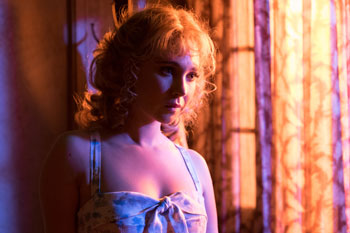 Fearing for her life, and with no other place to go, Carolina reaches out to Humpty, reasoning that, as her ex-husband knows how bitter her relationship is with her father, his home is the last place he would search for her. 'I'm not sure it's the safest plan, but I don't think she had any other option," says Juno Temple. 'But maybe it was also the subconscious, or even conscious, feeling that her father would protect her, as she was the apple of his eye when she was young. I think she goes into it with a childlike feeling that he will hopefully take her back, but she has no idea what she's going to walk in on, and doesn't necessarily think about the consequences that her arrival might bring to him. I think, in her innocence, her eyes tend to look on the bright side of life, and look forward and not backward."
Fearing for her life, and with no other place to go, Carolina reaches out to Humpty, reasoning that, as her ex-husband knows how bitter her relationship is with her father, his home is the last place he would search for her. 'I'm not sure it's the safest plan, but I don't think she had any other option," says Juno Temple. 'But maybe it was also the subconscious, or even conscious, feeling that her father would protect her, as she was the apple of his eye when she was young. I think she goes into it with a childlike feeling that he will hopefully take her back, but she has no idea what she's going to walk in on, and doesn't necessarily think about the consequences that her arrival might bring to him. I think, in her innocence, her eyes tend to look on the bright side of life, and look forward and not backward."
While Humpty is initially unwilling to forgive Carolina, he quickly softens. 'With Carolina, Humpty has a much richer, deeper love than he's experiencing with Ginny," says Jim Belushi. 'As soon as she arrives, it is like – boom! – he is filled with hope, love and purpose again. He has a second chance in life. From then on, it becomes all about saving extra money so that Carolina can go to night school and have a better life." Ginny does not appreciate Humpty's reactivated passion. 'I think she gets annoyed with Humpty because she's seeing a side of him that she's never seen before," says Kate Winslet. 'If Humpty can be that adoring of his daughter, why has he never been that adoring of Ginny? He's never doted on her and adored her the way that he does with Carolina. Humpty doesn't need much to keep him happy. When Carolina comes along, suddenly his very small world is complete, but Ginny wants so much more."
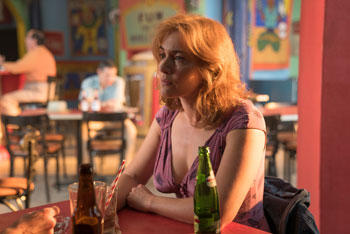 Mickey is also the narrator of Wonder Wheel. 'I think as the movie progresses, I think you start to question how reliable a narrator Mickey is," says Justin Timberlake. 'Because he clearly sees all these people that he is intertwined with in a very specific way. That is the just the way he sees them. Like the old saying that there's three sides to every story: the two sides, and then there's the truth, which is probably somewhere in between."
Mickey is also the narrator of Wonder Wheel. 'I think as the movie progresses, I think you start to question how reliable a narrator Mickey is," says Justin Timberlake. 'Because he clearly sees all these people that he is intertwined with in a very specific way. That is the just the way he sees them. Like the old saying that there's three sides to every story: the two sides, and then there's the truth, which is probably somewhere in between." One person Mickey pays special attention to is Ginny, as he spies her walking forlornly on the beach. He tunes into her dramatic melancholy immediately and finds it oddly appealing. 'Mickey is a hopeless romantic, and as an aspiring playwright, he finds flaws beautiful," says Justin Timberlake.
'That night he tells Ginny that there's something tragic about her, and I think he means that as a sort of compliment, like, -yeah, and that makes you incredibly sexy to me.' But I think he falls more in love with the tragedy of Ginny than with Ginny herself. He likes that she's in emotional peril." Says Woody Allen: 'Mickey's in love with the mystique of writing, of living in the village, of having an affair with or maybe even marrying an older woman. All these romantic notions of a struggling writer are appealing to him, as he tends to romanticise everything. I wouldn't call that a tragic flaw; it may even be an endearing flaw. The saddest part of his life is that he's probably not going to be the author that he wants to be. My guess is that Mickey will make a couple of attempts at writing and maybe there'll be some mediocre things he turns out, but he's not destined to be Euripides or Eugene O'Neill."
Up until she meets Mickey, Ginny had managed a life without hope, with a little help from headache pills and an occasional nip from a whiskey bottle hidden under the sink, but encountering him upends everything. 'Once she has Mickey in her life, the great dormant volcano that is Ginny is cracked open again," says Kate Winslet. 'Mickey represents a world that she had dreamed of in her wildest dreams. He's a real thing, she didn't invent him: they are making love; he is whispering sweet nothings to her; they are meeting under the boardwalk in the rain; and he is reciting great prose to her. She actually begins to believe that maybe she can have another life, one that Mickey seems to promise her. I think she does have moments of very real hope."
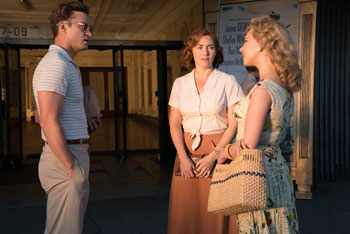 Everything changes after Ginny unwittingly introduces Mickey to Carolina and he instantly taken by her. 'Mickey believes in love at first sight, and he falls really hard for Carolina," says Justin Timberlake. 'In the short time they spend together, as she peels layers back for him, the more he hears about her life, the more he becomes fascinated with the chances that she took at such a young age because she felt like she was in love with somebody. I think that's where he goes, -Oh wait. We're more alike than I knew.'"
Everything changes after Ginny unwittingly introduces Mickey to Carolina and he instantly taken by her. 'Mickey believes in love at first sight, and he falls really hard for Carolina," says Justin Timberlake. 'In the short time they spend together, as she peels layers back for him, the more he hears about her life, the more he becomes fascinated with the chances that she took at such a young age because she felt like she was in love with somebody. I think that's where he goes, -Oh wait. We're more alike than I knew.'" 'There's a passion inside Mickey and I think Carolina has got that too," says Juno Temple. 'He's an artist and he represents a new kind of glamour for her, which is coming from books and plays and conversations about far-off places. Her receiving a book from him tickles something in her that is a new excitement, and she likes being wooed by him. I think he's a very good wooer – he did it with Ginny and now he's doing it with Carolina."
Ginny's awareness of Mickey's growing infatuation with Carolina provokes an intense reaction within her. 'She hasn't experienced great jealousy before and I think it takes her by surprise," says Kate Winslet. 'I think she's really consumed by both the feeling of jealousy itself as well as the awareness that it's setting her off kilter. Then the jealousy does set in big time, and it makes her crazy. There are no other words for it – it makes her crazy."
Kate Winslet found portraying the swings of Ginny's mercurial personality to be all-consuming. 'She demanded so much of me that in a very strange way I played second fiddle and Ginny really took over," says Kate Winslet. 'There are things that are so violently shaky inside of her that the way she thought and functioned was exhausting. It was almost like I was trapped in fight or flight mode. It was like 24-hour theatre. I really did feel like I had a battery in me somewhere and I had to keep permanently on charge. But still, there's nothing about the experience of making this film – including the fear and the stress of it all – that I didn't like. I loved that feeling of being utterly wrung out, challenged, and bled dry. It was the single most exhilarating filming experience I've ever had."
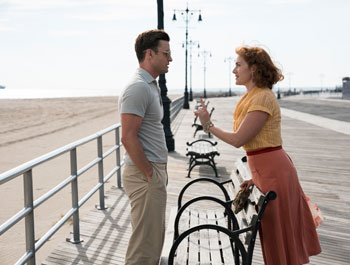 Whatever Kate Winslet put herself through to play the role, Allen found her to be a picture of control on the set. 'If there was a beat in a scene or an emotion in a scene that I needed, or if I would give her a correction, she instantly gave back exactly what I was looking for in a very deep way," says Allen. 'It was amazing. I said to her it was like having a nuclear weapon at your disposal.
Whatever Kate Winslet put herself through to play the role, Allen found her to be a picture of control on the set. 'If there was a beat in a scene or an emotion in a scene that I needed, or if I would give her a correction, she instantly gave back exactly what I was looking for in a very deep way," says Allen. 'It was amazing. I said to her it was like having a nuclear weapon at your disposal. She could do anything and she did it quickly and superbly. All you had to do is be clear to her what you wanted and you got it. Most of the time, I never even had to be clear to her – she read the script and she got it. If she had a question or two, she'd ask me. I was not going to interfere with what makes Kate Winslet great, unless I had to." Says Kate Winslet: 'If a scene was not going well Woody would go, -Stop, we've got to fix this' and then he would say, -Now how do I direct you out of this hole I've written you into?' We would laugh and then we would figure it out."
Allen sees Justin Timberlake as being in the mode of the old fashioned Hollywood movie star, in the best sense. 'If these were the 1930s or 40s or 50s, he would have been right there with the Gables and the Bogarts," says Woody Allen. 'That would have been his milieu. He lights up the screen whenever you put the camera on him. Justin Timberlake has it all. He's a first-rate actor and he's completely believable as a lifeguard and a heartthrob to the women on the beach." Justin Timberlake also expresses pleasure with working with Woody Allen. 'Woody Allen has his own process," says Justin Timberlake. 'It's fast and there's not a lot of coverage. He does very long takes and you get about two to five shots at every scene. At first it was really intimidating, but, after a while, I found it really freeing and fun, because I didn't have to worry about matching what I did before. And this caused me to keep discovering things. I felt like I was acting in a play with a group of really gifted and talented actors beside me."
Woody Allen first noticed Jim Belushi in Ed Zwick's 1986 film About Last Night… 'At the time I said, -Who is that guy?'" says Woody Allen. '-He's an extremely good actor, as strong as can be on the screen and he's touching. I said, -Maybe someday I'll give him a call.' Now we cut to 30 years later and I'm thinking, -Who would be perfect for Humpty?' and asked him to come in. I could tell after five minutes with him, that he would make a wonderful Humpty. I think he will surprise a lot of people with this. I think they're going to be surprised at what a tremendous actor he is, so full of emotion, full of reality and full of feeling." Says Jim Belushi: 'Woody gives you a lot of room. I worked for three months before shooting, memorising every comma in the script, but when I got to set he said, -These are writer's words. You do what you want to make the words your own. In the end, I only changed a few things here and there, but he was lovely to work with, and very funny to be around."
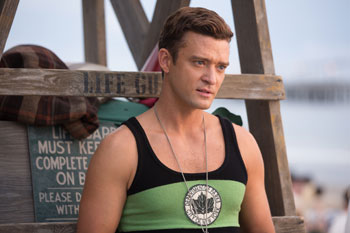 Woody Allen looked at numerous actresses for the role of Carolina but couldn't find somebody who had what he was looking for until casting director Patricia DiCerto brought in a tape of British actress Juno Temple. 'Juno Temple came through brilliantly for me," says Woody Allen. 'She is a very touching and real actress, and she had all the elements to play the character. First, she was pretty and sexy enough to be the apple of the eye in a real life situation, yet she wasn't this Hollywood glamorous beauty like Marilyn Monroe who you'd never believe would have any problems in Coney Island or any place else. And second, she didn't come off as too refined. I'm sure Juno can play 'Masterpiece Theatre" type roles, but here she was able to play a kind of lower class, Coney Island denizen." Like her colleagues, Temple recognized Allen's unique directorial approach. 'Woody does not give a huge amount of feedback, but when he does it's very profound and on-point," she says. 'The long, fluid scenes we did were choreographed like dances with dialogue, and he was very specific about where he wants people to land because of how it fills the frame. Sometimes he would just want you to move a foot to the left for a certain piece of lighting." Temple says there was great camaraderie on set among the actors. 'Everybody was in the same boat of wanting to do the best with this incredible material and also to really support everyone else. We ran lines together in between takes and sometimes in the evenings, and guided each other through it. When you trust your co-stars, you are able to give it all you've got, and I really felt that all of us did that."
Woody Allen looked at numerous actresses for the role of Carolina but couldn't find somebody who had what he was looking for until casting director Patricia DiCerto brought in a tape of British actress Juno Temple. 'Juno Temple came through brilliantly for me," says Woody Allen. 'She is a very touching and real actress, and she had all the elements to play the character. First, she was pretty and sexy enough to be the apple of the eye in a real life situation, yet she wasn't this Hollywood glamorous beauty like Marilyn Monroe who you'd never believe would have any problems in Coney Island or any place else. And second, she didn't come off as too refined. I'm sure Juno can play 'Masterpiece Theatre" type roles, but here she was able to play a kind of lower class, Coney Island denizen." Like her colleagues, Temple recognized Allen's unique directorial approach. 'Woody does not give a huge amount of feedback, but when he does it's very profound and on-point," she says. 'The long, fluid scenes we did were choreographed like dances with dialogue, and he was very specific about where he wants people to land because of how it fills the frame. Sometimes he would just want you to move a foot to the left for a certain piece of lighting." Temple says there was great camaraderie on set among the actors. 'Everybody was in the same boat of wanting to do the best with this incredible material and also to really support everyone else. We ran lines together in between takes and sometimes in the evenings, and guided each other through it. When you trust your co-stars, you are able to give it all you've got, and I really felt that all of us did that." Wonder Wheel marks the second time that Woody Allen has collaborated with Award-winning cinematographer Vittorio Storaro, after Café Society. 'Vittorio Storaro is a major contributor and genius cameraman, so anything we decide on, he's always got some wonderful ideas for," says Woody Allen. 'It's a treat to work with someone who makes such a gigantic theatrical contribution to the project."
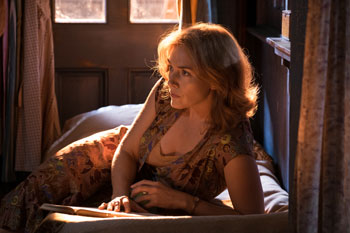 While in Café Society Storaro used colour to differentiate the looks of New York and Hollywood, in this film, he proposed to Allen an overall visual design that associates a contrasting colour range to the two main female characters. 'I believe that light and colour can be used in the same way as notes in music or words in a script," says Vittorio Storaro. 'There is a physiology of colour, where a very warm colour raises the metabolism or blood pressure on our bodies and a very cold colour lowers it. So I connected all the warmer wavelengths, yellow, orange, red, with Ginny, and I visualised Carolina in the specific wavelength of light blue. So the two colours become like two characters, and Mickey is in the middle, and he reflects the tonality of whichever one he is near." These colour treatments were not utilised in a solely abstract way, but always had to realistically reflect the places and times the characters are in.
While in Café Society Storaro used colour to differentiate the looks of New York and Hollywood, in this film, he proposed to Allen an overall visual design that associates a contrasting colour range to the two main female characters. 'I believe that light and colour can be used in the same way as notes in music or words in a script," says Vittorio Storaro. 'There is a physiology of colour, where a very warm colour raises the metabolism or blood pressure on our bodies and a very cold colour lowers it. So I connected all the warmer wavelengths, yellow, orange, red, with Ginny, and I visualised Carolina in the specific wavelength of light blue. So the two colours become like two characters, and Mickey is in the middle, and he reflects the tonality of whichever one he is near." These colour treatments were not utilised in a solely abstract way, but always had to realistically reflect the places and times the characters are in. 'Ginny is often seen at -sunset time,' when the warm tonalities of red/orange of the sun represent symbolically her attachment to the past," says Vittorio Storaro. 'As Carolina is linked to the future, she lives mainly in the blue of the -magic hour,' the time between the sun setting and the moon rising." The most dramatic example is within the family apartment, which is so close to the Wonder Wheel that the attraction's lights cast deeply saturated reds and blues over the characters. 'What we were trying to do with this film was create a theatrical drama," says Woody Allen. 'They are living amidst all this turbulence right outside their window, including gunfire from downstairs and lights changing the colour of their apartment all the time. I wanted it to have a poetic and theatrical flare, but to retain the realism so you get involved with the characters and care about the story. But colours change in the middle of scenes to emphasise the theatrical tragedy that underlies the story."
Storaro also found visual inspiration in the Coney Island paintings of artist/photographer Reginald Marsh, as well as the work of Norman Rockwell. 'Rockwell presented a positive way of living during the 50s in the United States," says Storaro. 'Which was a kind of a surface. You can have that feeling when you arrive in Coney Island, but when you go deeper and get inside the personal life of the family in this story, you find something completely different. He was a great reference to show that kind of conflict: what was on the surface of these people and what was in their interior." Likewise, 'Coney Island Washboard," the Mills Brothers song that runs through Wonder Wheel, plays a similar role as a counterpoint. 'Coney Island is always thought of in that bouncy, lively way," says Woody Allen. 'But it's ironic, as that's not what is going on for these characters." Woody Allen's idea for Humpty and Ginny's apartment was that they would be living right in the heart of the amusement park, with no escape from the din and constant flickering lights. Production Designer Santo Loquasto found a location on the second floor of a building in Nyack, New York, that Allen and cinematographer Storaro liked, but eventually the filmmakers decided it would be more efficient for Loquasto to build something similar at Silvercup Studios in Long Island City, New York. 'The character of the space is very vulnerable and full of windows." says Santo Loquasto. 'It's a voyeuristic space from which there is no escape from the park. The kitchen is almost like an early loft space and it's just imposed into the space. There's still part of a ticket booth. My original idea was that it had gone through many backstories, where it maybe had once been amusement park offices, and that it had been altered for housing employees. I even have signs up in the rafters that implied it had once been a 'Ten Cents a Dance" type of place at some point."
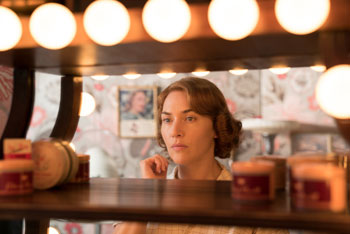 Aside from the apartment set, the rest of the movie was shot on real locations in Coney Island and elsewhere in New York City. Santo Loquasto found a lot of his historical references from various books, the Historical Society for Coney Island, as well as online sources. 'We used places that existed then and then made them look like what our research showed us it looked like at the time," says Santo Loquasto. 'Although we didn't use studio sets, we had to do quite a bit of construction. We built a lot of storefronts in front of storefronts so you you'd see more period facades." Around the Coney Island amusement park, Santo Loquasto and his team changed a lot of the modern signage and covered the facades of the rides with gigantic printed images. 'With people in period costumes standing in front, it looks pretty convincing," says Santo Loquasto. Ruby's Clam House, where Ginny and Carolina work, is an actual restaurant on the boardwalk, currently called Ruby's Bar & Grill. 'They had wonderful photos," and we supplemented them and took it back to closer to what it had been in the 1950s," says Santo Loquasto. Some of the other notable locations include: The Freak Bar, the lobby lounge bar of the Coney Island Freak Show, where Ginny and Mickey first talk; Capri's Pizzeria, which had its interior at Sam's on Court Street in Cobble Hill, Brooklyn; a Carvel at Playland in Rye, New York; and the New York Chinese Scholar's Garden at Snug Harbor in Staten Island.
Aside from the apartment set, the rest of the movie was shot on real locations in Coney Island and elsewhere in New York City. Santo Loquasto found a lot of his historical references from various books, the Historical Society for Coney Island, as well as online sources. 'We used places that existed then and then made them look like what our research showed us it looked like at the time," says Santo Loquasto. 'Although we didn't use studio sets, we had to do quite a bit of construction. We built a lot of storefronts in front of storefronts so you you'd see more period facades." Around the Coney Island amusement park, Santo Loquasto and his team changed a lot of the modern signage and covered the facades of the rides with gigantic printed images. 'With people in period costumes standing in front, it looks pretty convincing," says Santo Loquasto. Ruby's Clam House, where Ginny and Carolina work, is an actual restaurant on the boardwalk, currently called Ruby's Bar & Grill. 'They had wonderful photos," and we supplemented them and took it back to closer to what it had been in the 1950s," says Santo Loquasto. Some of the other notable locations include: The Freak Bar, the lobby lounge bar of the Coney Island Freak Show, where Ginny and Mickey first talk; Capri's Pizzeria, which had its interior at Sam's on Court Street in Cobble Hill, Brooklyn; a Carvel at Playland in Rye, New York; and the New York Chinese Scholar's Garden at Snug Harbor in Staten Island. Costume designer Suzy Benzinger had to gather thousands of outfits for the extras, many of them original era garments purchased online or rented, and the rest made. 'Every person you see on that beach had three bags of clothing," she says. 'We wanted a lot of clothes on the beach, hanging from umbrellas, because a lot of people couldn't afford the ten cents to change in the bath houses, so they changed on the beach." However, it was not easy to coax modern gym-trained women's bodies into 1950s swimsuits and dresses. 'In those days the proportion of waist to hip was really drastic," says Suzy Benzinger. 'Today's women's muscles are different – they are a bit squarer." Suzy Benzinger had to have the extras wear waist-cinching foundations to provide the right shape under the 1950s clothes. 'They looked at us like we were going to torture them, and I had to repeatedly say, -Gals, this is what they wore.'" The only exception was Kate Winslet. 'She told me, -You're not going to have to do that with me. That's my figure, I was made for another era.' And it was true. I could take a real 1950s garment and put it on her and boom, right in there." Juno Temple also fit well into the 50s mode. 'She has a really curvy figure," says Suzy Benzinger. 'Even though she has a small waist, we cinched it in a little bit more for the va-va-voom effect."
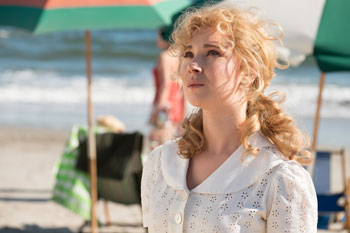 Suzy Benzinger made Kate Winslet's personal outfits deliberately uncomplicated. 'It's very button up the breast," says Suzy Benzinger. 'Kate Winslet and I felt that Ginny doesn't want to tip off her husband that she is having an affair, so she wears the same clothes that she wears all the time. The only thing we did is her undergarments get a little bit nicer as we go along in the film. The audience may not see that, but it helps the actress."
Suzy Benzinger made Kate Winslet's personal outfits deliberately uncomplicated. 'It's very button up the breast," says Suzy Benzinger. 'Kate Winslet and I felt that Ginny doesn't want to tip off her husband that she is having an affair, so she wears the same clothes that she wears all the time. The only thing we did is her undergarments get a little bit nicer as we go along in the film. The audience may not see that, but it helps the actress." The biggest costume challenge for Suzy Benzinger was Justin Timberlake's lifeguard uniform. 'I scoured and scoured for a photo," says Suzy Benzinger. 'I have this wonderful guy that I buy pictures from quite often, and he had two grainy, lousy pictures of the lifeguards at Coney Island."
Suzy Benzinger somehow found a 1949 issue of Esquire magazine that had an interview with the head lifeguard, Marty Alvin. She tracked him down in Florida and he sent her a scrapbook of old blackand-white photos and described the colours for her. 'The originals were coarse knitted wool, but I thought, -Justin Timberlake will take a gun to my head if I make it in wool, so we did a combination of wool and rayon so he wouldn't totally itch himself to death. I think he wasn't thrilled at first, but listen, he's got a great physique, what does he have to worry about? He looked great in it!"
The spectacular recreation of crowded Coney Island beach in the 1950s was helped optically. Brainstorm Digital, the special effects team, made a huge contribution. The entire boardwalk behind the beach, including buildings, concession stands, booths, and all the vintage rides, were recreated through photo-realistic visual effects. While the real Wonder Wheel is seen in the shot of Carolina's entrance, the one visible through the windows of the family apartment was created by Brainstorm Digital, along with a 270° view of The Cyclone, Parachute Jump, buildings, signage, trees, beach, ocean, and sky. Not only did the visual artists have to create that illusion, they also had to match the subtle lighting cues created by cinematographer Storaro.
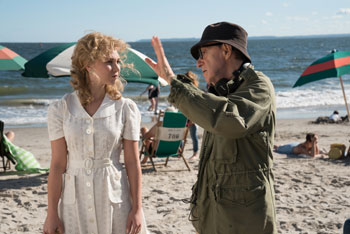 'Vittorio works with a dimmer board where he's changing the lighting and colour very intricately throughout a shot," says on-set VFX supervisor/producer Richard Friedlander. 'I describe Vittorio's work as a form of dynamic painting with colour and light, and we had to coincide our visual effects world with that in post-production." Says visual effects supervisor Eran Dinur: 'I believe everyone here on the crew would agree it was our biggest challenge to date, not only because of the intricacies and complexity of the lighting, but also a constantly moving camera, changing perspective, direction, lens, and size of frame." Also, as Woody Allen works with long takes, the shots in Wonder Wheel are considerably longer than they are in conventional films. 'Instead of shots that were 150 frames long, the length of the vfx shots were anywhere from 2000 to over 5000 frames," says visual effects producer Glenn Allen.
'Vittorio works with a dimmer board where he's changing the lighting and colour very intricately throughout a shot," says on-set VFX supervisor/producer Richard Friedlander. 'I describe Vittorio's work as a form of dynamic painting with colour and light, and we had to coincide our visual effects world with that in post-production." Says visual effects supervisor Eran Dinur: 'I believe everyone here on the crew would agree it was our biggest challenge to date, not only because of the intricacies and complexity of the lighting, but also a constantly moving camera, changing perspective, direction, lens, and size of frame." Also, as Woody Allen works with long takes, the shots in Wonder Wheel are considerably longer than they are in conventional films. 'Instead of shots that were 150 frames long, the length of the vfx shots were anywhere from 2000 to over 5000 frames," says visual effects producer Glenn Allen. While the film is called Wonder Wheel because of the Coney Island amusement park ride always visible from the family home, the title also has a metaphoric resonance. 'The same behaviours keep going around and around for these characters," says Jim Belushi. 'As much as Humpty wants to change, as much as Ginny wants to change, they keep going through their same patterns. It's a vicious cycle of their lives and their co-dependencies, and they can't break out." Says Woody Allen: 'It's probably true that you can extrapolate some kind of symbol for life from any amusement park ride. Either you're on the Wonder Wheel going inexorably round and round as life turns meaninglessly, or you're riding a carousel trying to catch that brass ring that you'll never really get, or you're on the rollercoaster. You get the idea. The view is beautiful from the Wonder Wheel, but you're going no place. It has an element of romance to it, an element of beauty to it, but ultimately, an element of futility."
Wonder Wheel
Release Date: December 7th, 2017
MORE
- Mission: Impossible Fallout
- Glenn Close The Wife
- Allison Chhorn Stanley's Mouth Interview
- Benicio Del Toro Sicario: Day of the Soldado
- Dame Judi Dench Tea With The Dames
- Sandra Bullock Ocean's 8
- Chris Pratt Jurassic World: Fallen Kingdom
- Claudia Sangiorgi Dalimore and Michelle Grace...
- Rachel McAdams Disobedience Interview
- Sebastián Lelio and Alessandro Nivola...
- Perri Cummings Trench Interview

